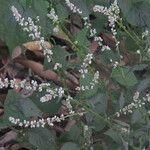Leaves narrowly lanceolate to broadly ovate, occasionally (mostly in S. Africa) with a broad, obtuse lateral lobe on each side near the base, acute to acuminate, glabrous or with short, few-celled hairs on the inferior surface about the base; lamina of main stem leaves (1) 2–8.5 (10) × (0.4) 1–4 (5) cm., subcordate to truncate or attenuate below, the lower margins often scabrid, more or less decurrent along the slender, up to more or less 5 cm. long petiole; superior and branch leaves smaller and often narrower, more shortly petiolate; all leaves often fallen by the fruiting stage.
A herb. It is branched and straggling. It grows 25-120 cm tall. The leaves are alternate. The lower leaves have long leaf stalks. The leaves are oval and about 8 cm long. The plant looks like Amaranthus hybridus until it starts to flower. Where the leaf stalk joins the stem there is a pair of small moon-shaped leaflets that lie around the stem. The small flowers are crowded together in separate clusters. They are 5-10 cm long. They are white or silvery. The fruit is a capsule which is almost round and has several seeds.
Herbs, annual. Stems erect or straggling, 0.5-1 m, glabrous. Leaves: petiole elongate, to 6 cm; blade unlobed, lanceolate or ovate, to 3-11 × 1-6 cm, base tapering, apex acuminate. Inflorescences interrupted, lax spikelike panicles, units less than 10 mm diam. Flowers: tepals silvery, whitish, or tannish, 1-veined, ovate, 2-3 mm, membranous, margins faintly erose, apex rounded-acute; style 0.2 mm; stigmas 3. Utricles 3-3.5 mm. Seeds 4-8, 0.7-1 mm diam., faintly reticulate. 2n = 18.
Inflorescences axillary and terminal, simple or branched spike-like thyrses more or less 6.5–35 cm. long, formed of distant or (at least above) approximate, few-to many-flowered lax or congested and subglobose, white or pinkish clusters 2–20 (30) mm. in diam., in well-grown individuals the superior leaves much reduced so that a terminal panicle is formed; inflorescence axis glabrous or furnished with multicellular hairs.
Perennial herb, scrambler, 0.4-0.5 m high. Leaves alternate, simple, entire. Inflorescences dense, terminal, slender spikes. Flowers bisexual, small, white, sessile or shortly pedicellate; bracteolate. Flowering time Feb. Fruit a membranous capsule, circumscissile, sometimes thickened at apex. Seeds black, usually strongly compressed and shining.
Tepals ovate-elliptic, 1.75–2.75 mm. long, shortly mucronate with excurrent midrib, glabrous, scarious with a narrow less translucent band along the midrib, margins minutely denticulate at least above.
Bracts and bracteoles ovate to ovate-elliptic, c. 1.25–2 mm. long, scarious with a darker nerve, margins minutely (or more coarsely at the base) erose-denticulate, glabrous.
Glabrous annual herb, up to 0.7 m high. Flowers in fascicles along floriferous branchlets. Perianth usually drying scarious white, ± 3 mm long.
Seeds c. 0.75 mm. in diam., compressed, black, shining, with a rather fine reticulate pattern, the areolae only slightly convex.
Stem and branches green to reddish, sulcate or striate, glabrous or with short, few-celled hairs especially about the nodes.
Free portion of filaments subequalling the sheath, sinuses rounded with no intermediate teeth; anthers reddish.
Capsule ovoid, 1.75–2.25 mm. long, included or a little exserted, rounded and not thickened at the apex.
Laxly erect annual herb, decumbent below, 6–24 in. high, or straggling up a support to about 4 ft.
Annual herb, erect, simple or branching from near the base upwards, (8) 30–120 (180) cm.
Stigmas 2–3, longer than the very short style; ovary 6–8-ovulate.
Flowers white with pink stamens

